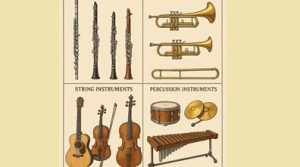Syncopation in Music: Unlocking Rhythmic Brilliance
Syncopation in Music: Unlocking Rhythmic Brilliance
If you’ve ever felt the irresistible urge to move, tap your foot, or nod your head while listening to a song, you’ve likely experienced the magic of syncopation.]

It’s a rhythmic phenomenon that adds energy and groove to music, captivating listeners across genres.
Read More: musical-terms-a-handy-guide-to-essential-music-glossary/
Syncopation in Music: In this guide, you’ll discover:
- What syncopation is and how it works.
- When to use (or avoid) syncopation in your music.
- Real-world syncopation examples in action.
- Practical syncopation patterns to spice up your rhythms and melodies.
How syncopated rhythm shines in video game soundtracks.
Let’s dive in!
What is Syncopation in Music?
Syncopation disrupts the expected rhythm by emphasizing off-beats or weak beats.
This unexpected stress creates a dynamic, engaging flow that makes the music feel lively and textured.
Here are some key types of syncopation:
- Accents: Emphasizing a note more than surrounding ones through volume or duration.
- Off-beats: Accenting weak beats to create forward momentum.
- Suspension: Playing a note just before the beat, building tension released on the beat.
These techniques add complexity and intrigue to music, which we’ll explore further with examples and applications.
Why is Syncopation Important?
Syncopation enriches music by:
- Adding Interest: Breaking predictable rhythms keeps listeners engaged.
- Creating Groove: Accenting weak beats injects funk and movement into a piece.
- Building Tension and Release: Off-beat accents create anticipation, resolving beautifully on strong beats.
Understanding syncopation starts with mastering strong and weak beats.
Strong vs. Weak Beats
In common 4/4 time, there are four beats per measure. The first and third beats are strongest, while the second and fourth are weaker. The strongest beat is the “downbeat” (first beat).
When harmony aligns with strong beats, it feels “natural.” Shifting harmony to weak beats creates tension – enter syncopation!
Syncopation and Beat Subdivision
Breaking beats into smaller units (e.g., quarter notes into eighths or sixteenths) opens new syncopation opportunities. Accentuating these subdivisions is a hallmark of groove-centric genres like funk and jazz.
For example, in Michael Jackson’s Thriller, syncopation is achieved through displaced sixteenth notes, creating its unmistakable rhythm.
Syncopation across Genres
The Syncopation spans countless styles, including:
- Pop: Michael Jackson’s Thriller, Bruno Mars’ 24K Magic.
- Rock: Led Zeppelin’s Kashmir, Muse’s Uprising.
- Funk: Parliament’s Flash Light, Prince’s Kiss.
- Jazz: Miles Davis’ So What, John Coltrane’s Blue Train.
- Hip-Hop: Kendrick Lamar’s DNA, Snoop Dogg’s Drop It Like It’s Hot.
- Latin: Bossa Nova, Salsa, Samba.
- African: Afrobeat, Highlife, Juju.
Syncopation is a cornerstone of musical expression across the globe.
Syncopation in Dance Music
Dance music relies heavily on syncopation. Instruments often play syncopated rhythms over steady drum beats, creating catchy grooves.
Listen to Deadmau5’s Closer for a masterclass in offbeat syncopation.
Common Types of Syncopation
- Suspension: Notes extend over chord changes, creating tension that resolves harmonically.
- Anticipation: Notes anticipate chord changes, hitting early to add excitement.
- Off-beats: Accenting weak beats for a rhythmic surprise.
- Polyrhythms: Interlocking rhythms, common in jazz and African music, for intricate textures.
- Hemiola: Alternating 3:2 or 2:3 patterns for rhythmic shifts.
Syncopation in Video Game Music
Syncopation is vital in video game scores, adding energy and variety to scenes.
Many iconic soundtracks use syncopation to heighten tension or create memorable grooves.
Popular Songs with Syncopation
Here are some popular songs across different genres that showcase syncopation in their rhythms and melodies:
Pop
- Michael Jackson – “Thriller”
Syncopation is prominent in the bassline, especially with the displaced sixteenth notes. - Bruno Mars – “Uptown Funk”
The offbeat emphasis in the groove makes this song irresistibly danceable. - Beyoncé – “Crazy in Love”
Features syncopated rhythms in the horn section and vocal delivery.
Rock
- Led Zeppelin – “Kashmir”
The polyrhythmic structure creates a layered and hypnotic syncopated groove. - Muse – “Uprising”
The bassline and drum rhythms often emphasize offbeats, creating tension. - The Police – “Roxanne”
Reggae-inspired syncopation is central to the groove.
Hip-Hop/R&B
- Kendrick Lamar – “DNA.”
The intricate rhythm in the beat uses syncopated hi-hats and bass. - OutKast – “Hey Ya!”
Syncopation drives the upbeat, funky rhythm. - SZA – “Good Days”
The vocal phrasing and instrumentation feature subtle syncopation.
Funk/Soul
- Prince – “Kiss”
The minimalist rhythm features syncopation in both the guitar and vocal phrasing. - Stevie Wonder – “Superstition”
The iconic clavinet riff emphasizes offbeat accents for a funky feel. - James Brown – “Get Up (I Feel Like Being a) Sex Machine”
The groove heavily relies on syncopated rhythms between the instruments.
Jazz
- Miles Davis – “So What”
Syncopated rhythms in the piano and bassline give the piece a distinctive flow. - Dave Brubeck – “Take Five”
The irregular time signature (5/4) naturally incorporates syncopation. - John Coltrane – “Giant Steps”
Features syncopation in its complex melodic lines.
Latin
- Gloria Estefan – “Conga”
Syncopation in the percussion drives the rhythm. - Santana – “Oye Como Va”
The melody and rhythm interact through syncopated patterns. - Luis Fonsi – “Despacito”
Reggaeton rhythms are inherently syncopated.
Electronic/Dance
- Deadmau5 – “Strobe”
Features syncopated synth patterns layered over a steady beat. - Daft Punk – “Get Lucky”
Syncopation in the guitar and basslines contributes to the groove. - Calvin Harris – “Summer”
The rhythm and melody interplay feature syncopated accents.
Other Notable Mentions
- Queen – “Another One Bites the Dust”
Bassline syncopation gives the song its iconic groove. - The Beatles – “Come Together”
Subtle syncopation in the vocal phrasing and instrumentation. - Eminem – “Lose Yourself”
The stressed offbeats in the piano motif create tension and drive.
These songs exemplify how syncopation adds movement, groove, and energy to music, often making it memorable and engaging.

Final Thoughts
Syncopation is a powerful tool to elevate your music, making it more engaging, groovy, and dynamic.
Whether you’re composing jazz, pop, or video game music, mastering syncopation unlocks endless creative possibilities.
If you’re eager to explore more, check out my course on composing for video games—it’s packed with real-world examples and techniques.
Happy composting!






Thank you for your sharing. I am worried that I lack creative ideas. It is your article that makes me full of hope. Thank you. But, I have a question, can you help me?
Your article helped me a lot, is there any more related content? Thanks!
Thank you for being of assistance to me. I really loved this article. http://www.kayswell.com
Thank you for your post. I really enjoyed reading it, especially because it addressed my issue. http://www.kayswell.com It helped me a lot and I hope it will also help others.
Please provide me with more details on the topic http://www.kayswell.com
Please provide me with more details on the topic http://www.kayswell.com
Your articles are very helpful to me. May I request more information? http://www.kayswell.com
Howdy just wanted to give you a quick heads up. The words in your article seem to be running off the screen in Ie. http://www.kayswell.com
I am really loving the theme/design of your weblog. Do you ever run into any browser compatibility issues? A few of my blog readers have complained about my site not working correctly in Explorer but looks great in Firefox. Do you have any advice to help fix this issue? http://www.hairstylesvip.com
You’re so interesting! I don’t suppose I have read something like this before. So nice to discover another person with a few genuine thoughts on this subject. Seriously.. many thanks for starting this up. This web site is something that’s needed on the web, someone with a little originality! http://www.hairstylesvip.com
Your point of view caught my eye and was very interesting. Thanks. I have a question for you.
Awesome! Its in fact remarkable post, I have got much clear idea on the topic of
froom this paragraph. https://Bookofdead34.wordpress.com/
Thanks for sharing. I read many of your blog posts, cool, your blog is very good. https://www.binance.info/en-IN/register?ref=UM6SMJM3